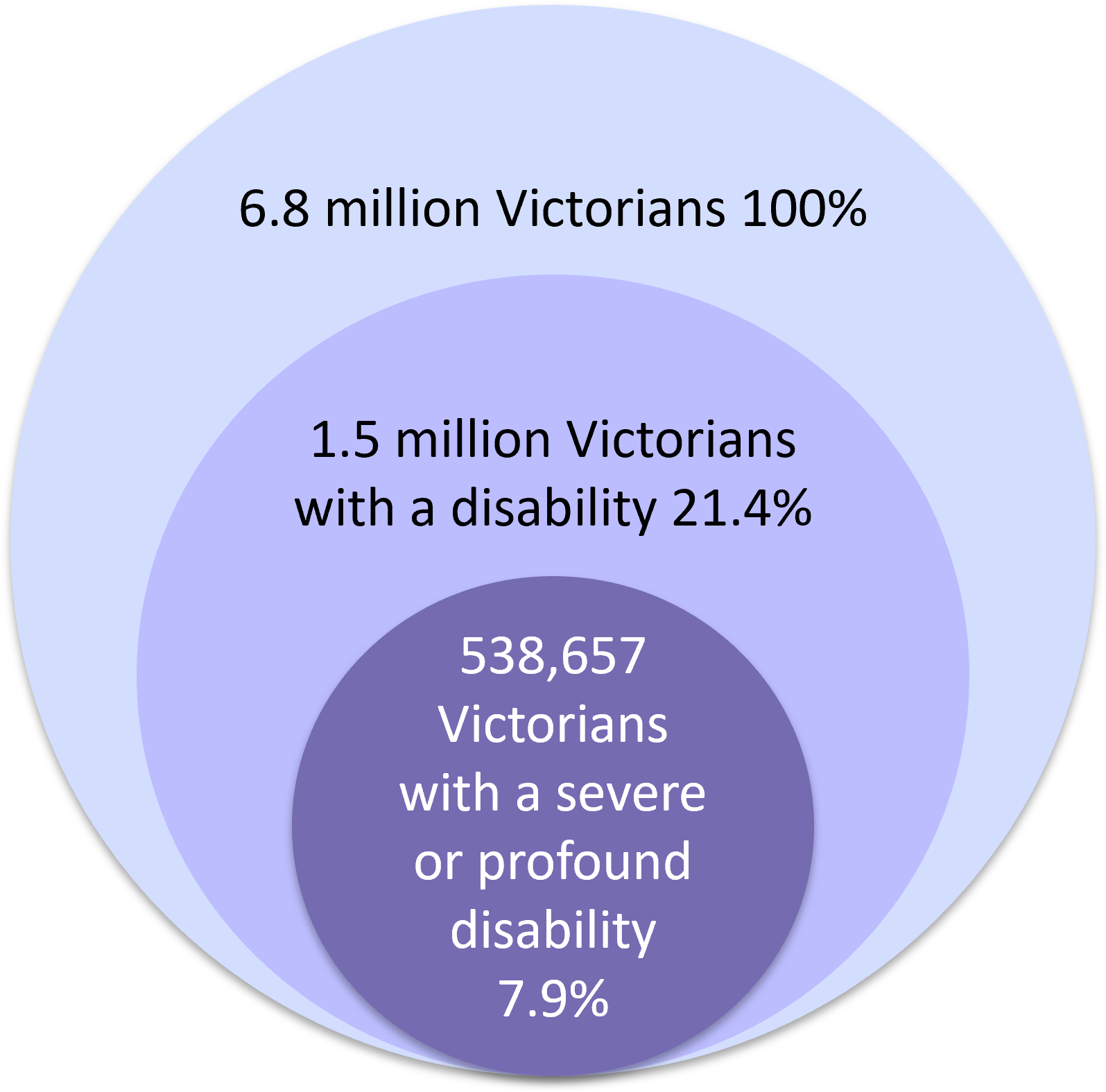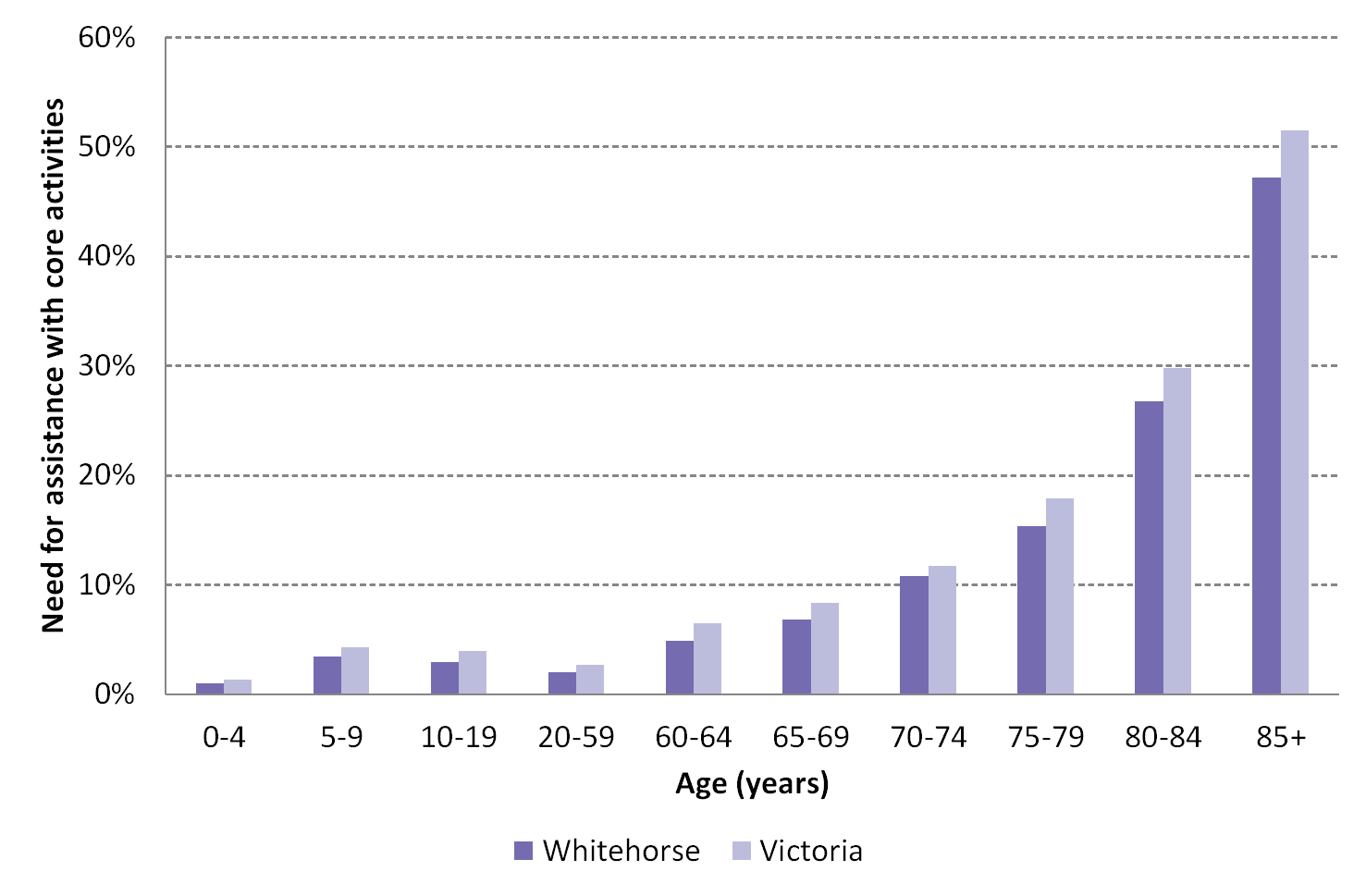This factsheet provides demographic information about people with a disability in the City of Whitehorse. Although primarily based on 2021 Census information, different statistical sources were used to compile this factsheet. The definition of disability changes between statistical sources which makes direct comparison difficult.
Prevalence of Disability
The 2018 Survey of Disability, Ageing and Carers (ABS 2019) [SDAC] found that 4.4 million people in Australia (17.7 per cent) reported having a disability. This data is not broken down into local government areas; however, when applying the Victorian percentage of 17 per cent to Whitehorse’s estimated population of 172,316 residents, approximately 29,300 residents may report having a disability. Around 15 per cent had a specific limitation or restriction such as a schooling or employment restriction (e.g. unable to attend or required specific equipment) and or limitation with core activities. A further 22.5 per cent of people undertaking the SDAC reported a long term health condition that did not restrict their everyday activities.
As depicted in Diagram 1, of the 17 per cent of people reporting a disability, 5.6 per cent reported a severe or profound disability.
The rate of disability increases with age. Reports of disability for Whitehorse residents were less prevalent in children four years or under (1 per cent) than for people aged between 65-69 years (7.5 per cent) or in comparison to people aged 85 plus (50.6 per cent) reporting a disability.

Disability Type
Disability types tend to be classified under broad categories that relate to the primary disability. Categories differ between statistical sources and where self-report is used it relies heavily on the person’s understanding of what is the primary disability. A person with a physical and intellectual disability may identify one or the other as the primary disability.
Of the 4.4 million Australians with disability in 2018, over three-quarters (76.8 per cent) reported a physical disorder as their main condition (the condition causing them the most problems), similar to 2015 (78.5 per cent) (SDAC, 2018). The most commonly reported physical conditions are musculoskeletal disorders (29.6 per cent) and back problems (12.6 per cent). For mental and behavioural disorders, psychoses and mood disorders (7.5 per cent) and intellectual and development disorders (6.5 per cent) are the most commonly reported conditions.

Psychosocial Disability
Psychosocial disability includes mental illness, memory problems, periods of confusion, social or behavioural problems or nervous and emotional conditions which cause restrictions in everyday activities. In 2015, 4.5 per cent of Australians (1,045,900 people) reported having a psychosocial disability. Of all people with a disability, almost one-quarter (24.4 per cent) had a psychosocial disability.
The 2015 SDAC showed that the majority of the 1,045,900 people who reported a psychosocial disability reported having one or more other impairments or restrictions (87.4 per cent). Two-thirds (66.2 per cent) of those people with more than one impairment or restriction had a physical disability.
Almost two in five people (39.5 per cent) with a psychosocial disability also reported difficulties in learning or understanding, a rate more than four times higher for people with a disability other than psychosocial (8.9 per cent). Around one-third of people (34.9 per cent) with a psychosocial disability reported having a sensory disability (i.e. loss of sight or hearing or speech difficulties).
Many people with psychosocial disability reported that they had more than one long-term health condition. These conditions may contribute to or coexist with their disability. In 2015, the most common long-term health conditions among all people with psychosocial disability were anxiety related disorders (which included phobic and anxiety disorders, nervous tension and stress) and depression—39.5 per cent and 37.6 per cent, respectively.
Other long-term health conditions commonly reported amongst people with psychosocial disability included arthritis (27.4 per cent), back problems (24.5 per cent), and hypertension (22.2 per cent), in part reflecting the older age structures in this population. One in six people (15.4 per cent) with psychosocial disability had dementia (including Alzheimer’s disease).
Autism Spectrum Disorders
Autism is a developmental disorder which affects how a person communicates and relates to other people. It is a lifelong condition and can be characterised by difficulty in social communication; difficulty in social interaction; and restricted or repetitive behaviours and interests (SDAC, 2018).
As a lifelong condition the impact and experiences of people diagnosed with ASD vary greatly. ASD is often characterised by difficulties in communication and social interaction and restricted or repetitive behaviours and interests.
It is estimated (SDAC, 2018) that ASD presents in 1.3 per cent of males and 0.3 per cent of females under the age of 40 years. There were higher rates of ASD reported in the 5 to 9 years and 10 to 14 year age groups with a steady decline in rate in older age groups.
Comparison between the 2015 and 2018 Survey of Disability Ageing and Carers (SDAC) indicates that reports of autism have increased by 25.1 per cent.
Indigenous People Reporting a Disability
People from Aboriginal and Torres Strait Islander backgrounds experience higher rates of disability than other Australian population groups. Aboriginal and Torres Strait Islander populations are one and a half times as likely to have a disability or long-term health condition, and more than twice as likely to have a profound/severe core activity limitation (Australian Bureau of Statistics (2010), The Health and Welfare of Australia’s Aboriginal and Torres Strait Islander Peoples, Cat. No. 4704.0).
Approximately 0.3 per cent of residents in the City of Whitehorse identify as Aboriginal or Torres Strait Islander. Of the people identifying as Aboriginal or Torres Strait Islander 6.1 per cent of people reported a disability.
| LOCAL GOVERNMENT AREA | PEOPLE IDENTIFYING AS ABORIGINAL OR TORRES STRAIT ISLANDER | PRESENCE OF DISABILITY IN PEOPLE IDENTIFYING AS ABORIGINAL OR TORRES STRAIT ISLANDER |
|---|---|---|
| Boroondara | 0.3% (436 people) | 5.3% |
| Knox | 0.6% (1,022 people) | 10.4% |
| Manningham | 0.2% (297 people) | 11.8% |
| Maroondah | 0.6% (734 people) | 7.2% |
| Monash | 0.3% (522 people) | 6.3% |
| Whitehorse | 0.3% (523 people) | 10.3% |
| Yarra Ranges | 1.1% (1,713 people) | 9.6% |
Accessibility
Access to transport networks is a critical element of participation in society and can be particularly difficult where disability is present. In 2018, 40.9 per cent of Australians aged 5 years and over with disability used public transport. The majority of people with disability could use all forms of public transport (78.4 per cent), most with no difficulty (65.6 per cent). A further 6.3 per cent could use some but not all forms of public transport and 14.3 per cent could not use any.
Education Outcomes
The completion of schooling and higher levels of education are important for providing opportunities to people with disability to meaningfully participate in society and the workforce, as well as achieving financial independence. Participation in education can be affected by the support, assistance and equipment available for people with disability.
The disparity between educational outcomes for people with a disability and those without becomes more apparent when qualifications are considered. In Australia, a smaller proportion of people with disability (41.0 per cent) reported Year 12 or equivalent as their highest year of school completed compared with those without disability (62.8 per cent). Similarly, a smaller proportion of people with disability reported having completed a Bachelor Degree or above compared with those without disability (17.0 per cent and 30.1 per cent, respectively).
| EDUCATIONAL LEVEL | PEOPLE WITH A DISABILITY | PEOPLE WITHOUT A DISABILITY |
|---|---|---|
| Completed a Degree or higher | 17.0 | 30.1 |
| Completed Year 12 | 41.0 | 62.8 |
| Certificate Level | 28.4 | 22.5 |
Source: Australian Bureau of Statistics (2015), Survey of Disability, Ageing and Carers
People with a disability were more likely to have attained a Certificate level qualification (28.4 per cent) than those without a disability (22.5 per cent).
Employment Outcomes
In 2015 the Australian labour force participation rate for those aged 15-64 years with disability was 53.4 per cent, much lower than those without disability (83.2 per cent).
Generally, labour force participation decreases as the severity of disability increases. In 2015 Australians with a mild disability had a labour participation rate of 58.9 per cent while those with a profound or severe disability had a labour participation rate of 25 per cent. The same year 762,600 people aged 15 to 64 years with disability who were not in the labour force had an employment restriction, of which 74.3 per cent (566,700) were permanently unable to work.
In 2015, around two in five people of working age with disability (41.9 per cent) reported that their main source of income was a government pension or allowance. Those with a profound limitation were more than twice as likely to report a government pension or allowance as their main source of income (82.8 per cent) than those with a mild limitation (37.2 per cent) and the median gross income for a person with disability was $465 per week, less than half the $950 per week income of a person without disability.
Of the one million Australians aged 15 to 64 years with a disability who were employed just over half (52.6 per cent or 543,800) reported employment restrictions such as needing time off work (142,900) or special equipment (42,300) because of their disability.
Discrimination
In Australia over one-third of women (35.3 per cent) and over one-quarter of men (30.8 per cent) aged 15 years and over had avoided situations because of their disability. Older people (aged 65 years and over) were less likely to avoid situations because of their disability (21.2 per cent) than younger people (51 per cent).
Almost one in ten Australians with disability aged 15 years and over and living in households (9.6 per cent) reported they had experienced discrimination or unfair treatment because of their disability in the last 12 months. The rates of reported discrimination were slightly higher similar for women (10.3 per cent) compared to men (8.8 per cent). Higher proportions of young people with disability (aged 15 to 24 years) reported the experience of discrimination (18.9 per cent) compared to those aged 65 years and over (3.2 per cent).
Of those with disability who experienced discrimination, the most common sources of discrimination were service and hospitality staff (36.3 per cent) family and friends (21 per cent) and their employer (20.7 per cent).
Links
For more information about People With A Disability please refer to:


